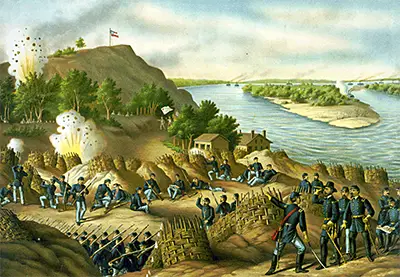Ulysses S. Grant: U.S. President, Civil War Victor
He volunteered to serve in the U.S. Army directly after the start of the Civil War and found himself as a colonel in charge of the 21st Illinois Infantry. After a promotion to the rank of brigadier general, Grant had command of the District of Southeast Missouri. Grant won significant victories in the West, at Fort Henry, Fort Donelson, and Shiloh. His most strategically important victory was the seizure of Vicksburg, in Mississippi, in July 1863, after a prolonged siege. 
By the end of June, Union forces numbered 70,000 and Confederate forces numbered 30,000. The defenders were ensconced behind thick walls and had the benefit of the high ground; however, they were surrounded and no longer had access to reliable supply lines. In fact, the city had been cut off for several weeks. Union troops built 15 miles of trenches around the city and then, their supply lines intact, settled in to wait. Day after day, shells from Union guns on land and on ship rained down on Vicksburg. The people inside the city hid in caves and resorted to eating animals to survive. On July 3, the Confederate commander, John Pemberton, agreed to surrender. Grant, accepting the terms, allowed the parole of the captured soldiers. On July 4, more than 29,000 Confederate soldiers marched out of the city and piled up their guns as a symbol of their surrender. Vicksburg was in Union hands, as was the Mississippi River. The last Confederate-held stronghold on the river, Port Hudson, also surrendered. It was on the very same day that Vicksburg surrendered that the Army of Northern Virginia was retreating from Gettysburg. Tempering the twin highlights for the Union somewhat was the refusal of the Confederate soldiers who had surrendered at Vicksburg to refrain from re-enlisting. In November of that year, Grant contributed to the Union conquest of Chattanooga. This battle featured the "Battle above the Clouds," the Union's storming of the Confederate position atop 2,400-foot-high Lookout Mountain. |
|
Social Studies for Kids
copyright 2002–2024
David White






